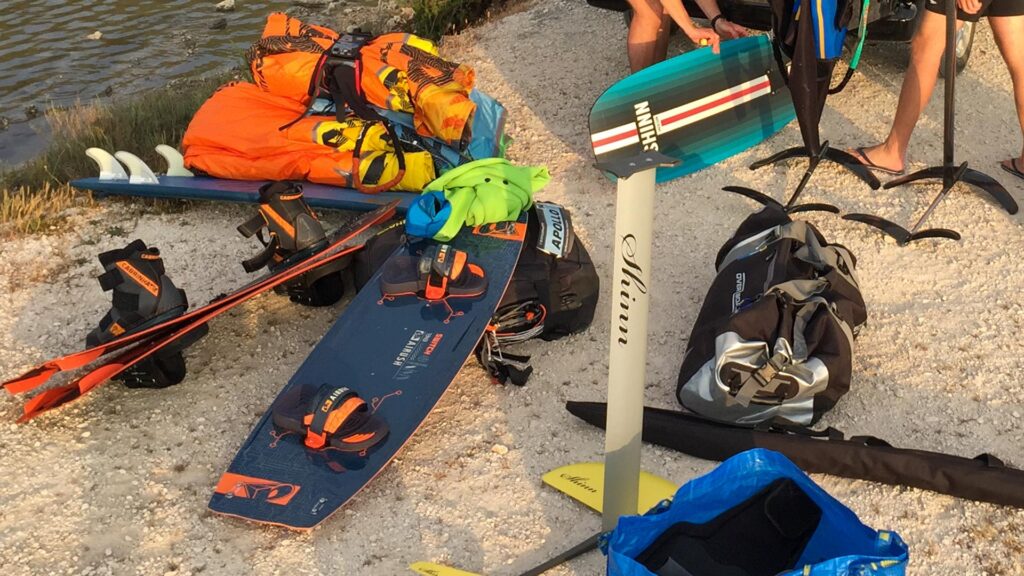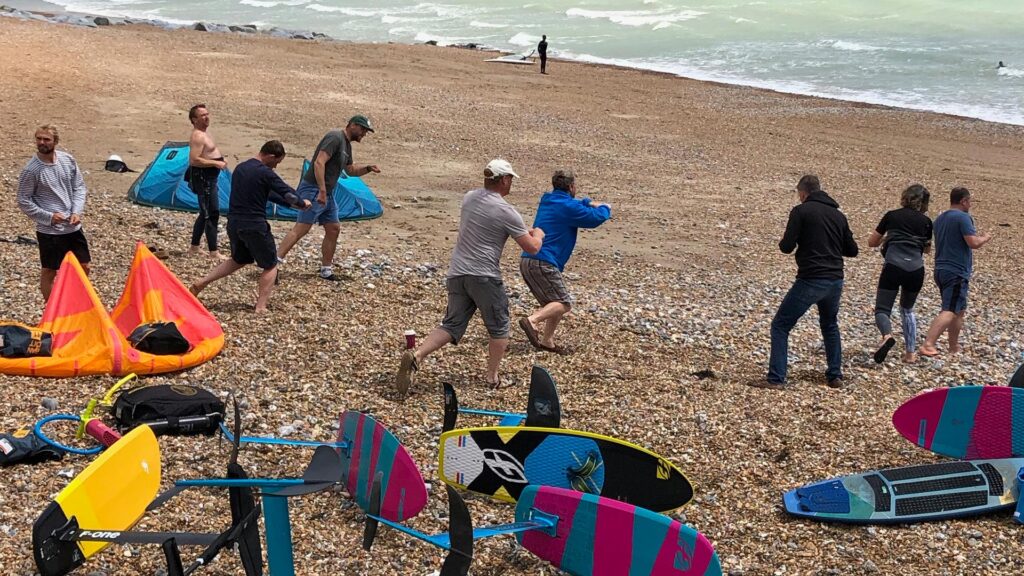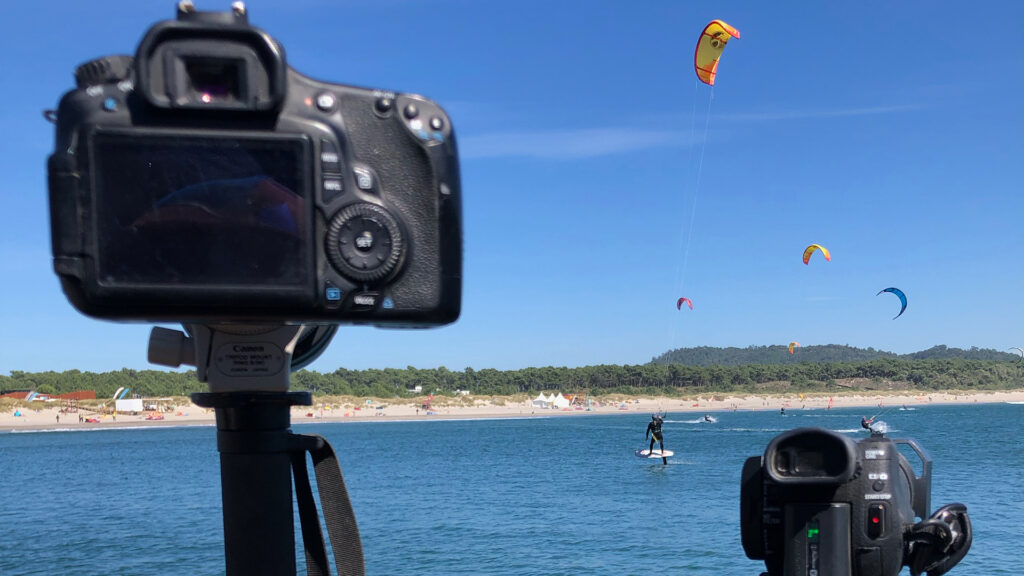There is no doubt, as a kitesurfer, you can spend a lot of money. For starters, there is the cost of equipment and if you want, there are all the upgrades and new disciplines we can continuously buy for and enjoy. Then, there are the hours we realistically need to invest in to see the improvements we all dream of. If we use the ‘time is money’ equation, kitesurfing is potentially very expensive. And, don’t forget the crashing! While we believe crashing is a critical part of the learning process and should be enjoyed (see our previous blog on crashing), it can also be quite costly in terms of its impact. Believe me, I have had my fair share of injuries that has cost me a lot of time off the water.
But the truth is, to become a better kitesurfer or learn a new discipline like kitefoiling, it can be a lot cheaper, way more efficient in terms of learning hours and really less painful than you think.
This blog is not specifically about how you can save money, it’s more about the most effective way to invest in your passion to get the most progression. We outline what we think are the priority areas that you can invest in to see the fastest and biggest improvements in all your kiting goals.
We see the potential investment as three main areas. We also believe the order and priority of these areas makes a difference to the gains you can make – decreasing your mistakes as well as saving you some pennies.
Investment priorities
- Understanding
- Time
- Equipment

Equipment
We are going to talk about equipment first. Even though we think of it as probably the last priority of these areas, it is often the first thing people turn to in order to get started and progress.
Hands up ? if you have found yourself stuck in a rut, not progressing, wanting to improve ‘right now’! Or just bored? And….. the first thing you do to solve this issue or frustration is to go out and spend some money on new kit? Don’t worry, we have all done it, been there, got the new kit :). We are even seeing a lot more people today buying kit before they have even learnt to fly a kite or have a kiteboarding lesson.
And….. the truth is, why not? Whether you are looking to get to the next level in your kiting or even start a new discipline, there is nothing like something new to kick start your motivation and intention. But what if it doesn’t fix the problem? Or actually becomes the thing that holds you back. Go out and buy more kit?
We see, all too often, how easy it is to turn to the ‘new kit fix’ to try and move things forward. But, here’s the thing; most of the time, new kit isn’t always the best place to invest in first to see the fastest gains.
We have lost count of the number of people we see on the wrong kit for their learning stage or ability. We can’t stress enough how important it is to get the RIGHT kit, FOR YOU, for WHERE YOU ARE at this point in your learning journey. A lot of the time people buy the kit ready for when they are a bit better, so they don’t need to buy twice. But a ‘WORD OF WARNING’; being on too advanced kit may actually slow you down and actually stop you getting to the level you were aiming for!
For most of us, the first point of advice comes from our more experienced kite friends. Absolutely nothing wrong with that as they should be able to guide us quite well, right? Except, most people’s experience is limited to their own learning journey and what works for them. Advice often has an unconscious bias towards their own ability, skill level, body type, weight etc etc. And don’t forget the bias towards the kitesurf brands they tend to favour, or are ambassadors for, or brands they need to just sell. The truth is, whilst this advice might be well-meaning, it may not be quite right for you.
So before you jump right in and invest in kit, here are some thoughts that might help you get the right kit first time;
Do your research and get a broad impartial view of how the kit works and feels for all levels and how it relates to your own needs and ability. Look for the positive and negatives and how this might help and hinder your kitesurf ambitions. For example, there is no point buying a boosting kite because you can get it at a good price, when you hate big jumps and just want to ride waves. Ask people you know have broad kit experience and expertise for the discipline you are looking to progress in. Don’t forget to always put your needs at the forefront of their advice before you part with your cash.
Don’t just go for what everyone else has. It might work for everyone else, but may not be quite right for you. We see this a lot in our foiling camps. People want the cool small boards, or buy a set-up because it was cheap….or actually the most expensive kit on the market. But once they have it they find they just can’t progress on it. It’s never nice telling people they have bought the wrong kit for their level.
We will talk more about board size in another post later – but here are a few reference points for broad guidance on kit. Of course, there is a lot more out on the big world wide web too – happy researching:
- Kiteworld gear reviews. What we like about this is you can filter your kit search to what you are broadly looking for. Search for your level and discipline, and then get reviewing.
- IKSURFMAG also have a wide range of reviews that are worth checking out
- Progression’s guide on twin tip boards

Time
Over the years of running Progression, it’s become really obvious that what holds people back the most, is time, or rather, lack of it. We’d all love to ride 7 days a week, but that is not practical or possible for most of us. And of course, when you do have time, there’s no bloody wind!!
We believe it is therefore really important to invest in the time you have properly to achieve the gains you want. Here are our tips on how to invest in time better that we share with our students to help progress their kiting as efficiently as possible:
Make sure you maximise your time on the water. Stop procrastinating on the beach, changing your mind on what size kite to fly. I know you may have not seen your kite buddies for a while, but make sure you don’t talk too long either. Spend as much of the time you have on the water.
Make the most of the time you have.
Stop cruising around and just mowing the lawn. Focus on specific goals and drills to work on and build your session into 20 or 30-minute drill sections to start developing specific skills.
Master of one vs Jack of all?
We also see a lot of people changing disciplines because they are bored or frustrated with where they are at. So we see them continuously changing boards and disciplines and not really developing any one of them. If you want to become a master then you need to put the time into developing that one discipline. Unless you have endless hours on the water to work across different disciples, we think it’s best to focus on one for a while in order to see more and faster gains in that discipline.
There is never a bad or non-productive day.
If the wind is light or drops and you are underpowered, there is always something you can practice to make the windier days more fun and productive. Bettering your kite skills will always make you a better kiter – and learning to kite in light winds is a skill that is massively undervalued and practised.
Learning kite loops is a brilliant light wind skill. Learning in the shallows without a board or in light underpowered winds are a perfect time to practice.
Check out our KiteSOFAing episode for some extra tips on how to kiteloop.
There are so many different conditions and scenarios that you can work with to learn new things and progress. Just get out there!
Land training
Learning and training for a new skill when you’re away from the beach can make the most of the time you do spend on the water. Find ways to mimic the skill or movement on land and spend time getting it right off the water. For example; the foot movement in a tack is easily practised on land. As is balance drills and foot changes on a foil or surfboard. You can even rig up a system to practice downloops and even get those twintip grabs positions worked out sitting on your sofa.
And there are lots of videos out there to watch and study off the water because the most important way to improve is to understand…

Understanding
Last month, in the feedback session of our five-day Progression camp, a client made a comment that the coaching week was actually the most cost-effective way of improving he had experienced. Funnily enough, this feedback was actually the inspiration for this blog.
After spending money on lots of different kites and foils, our client frustratingly found he was still not progressing. As part of our coaching program, we went through our teaching framework to work out the best way forward for him:
- Identifying specific kit needs according to the discipline level and then what the right and wrong bits of kit were for him.
- Specific drills were then essential to change the way our client was using the kit so he could get the best out of it and not waste any more time crashing and not progressing on it.
- Understanding how your kit works and how to ride it is essential to get the best out of it.
- Setting skill and session goals was also a massive step forward so our client could maximise his progression within the time on the water he had.
Unfortunately, this particular client does have to buy more kit. But the key point is; he could have saved money for sure, crashed way less and progressed much much faster had he invested in understanding what was right for him earlier.
Work on your weakness
A lack of understanding, whether this is around what kit to buy or even knowing how to really develop your skills, is a massive limiting factor to most people’s progression. Talking of skill development, we see poor technique even in the most experienced kiters – time and time again kiters with 15+ years flying a kite come for kitefoiling lessons and nearly every time they say the same thing “I thought I was good at flying a kite! I didn’t realise how rubbish I actually am!”. And it’s not that they are rubbish, it’s that in stronger winds we can paint over the cracks and often we can get away with more restrictive kite skills to do the specific things we do every session.
Constantly reviewing and understanding our skill weaknesses is a good thing. Ditch the ego, it’s what the best athletes from all sports do constantly to ensure they improve. It’s actually not a weakness to admit that you have areas that need work, or you were not as good at something as you thought you were. Believe me, there is always something to work on and perfect.
Whilst I don’t like being injured, I actually enjoy the message my body gives me about the weakness I have that has led to that injury. And I love the process of turning that weakness into a strength. Finding and acknowledging areas of work, potentially getting help to develop, is where progression and mastery starts.
Have a lesson, get some coaching
It is easy for us as coaches to say the best investment you can make is having a lesson to learn what you are doing wrong, or rather what you need to do right – but in all seriousness kiting instruction doesn’t have to end when you have learnt to waterstart.
The cost of a lesson is often the cheapest, fastest and less painful way to progress.
And obviously we are here to help…. Progression’s philosophy and foundations are based on this theory of understanding. We have made it our day job to understand every skill, trick and kit type and then distilling all that knowledge into a coaching path that will work for everyone. So you can save some time in your own quest for understanding and invest in just want you need, to get the most out of every session.
Check out Myself and Danny’s coaching page if you are keen to work with us. Or there are lots of brilliant coaches out there across the world. Drop us an email and we will try and guide you to the right coach in your area.
Or get started with our online coaching videos which can get you started with a better understanding of the next trick or technique you want to master.
What has made the biggest difference to your progression in the last 12 months?